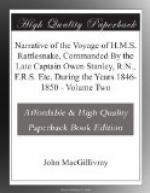(Footnote. See O’Byrne’s Naval Biographical Dictionary page 1109.)
By this unfortunate event all previous arrangements regarding our future proceedings were anulled. It had been intended by Captain Stanley to return to England by way of Singapore and the Cape of Good Hope, adding to the charts of the Inner Passage as we went along the east coast of Australia, and making a careful survey of the Strait of Alass, between the islands of Lombock and Sumbawa. Captain the Honourable Henry Keppel of H.M.S. Meander, as senior naval officer present, having appointed Lieutenant Yule to the vacancy in the command of the Rattlesnake, with orders to proceed direct to England, we left Sydney for that purpose on May 2nd. The Bramble was left behind in the colony, and in addition to her former crew, the limited accommodations of our ship were still further crowded with the greater number of the Port Essington marines, some invalids, and other passengers, making up the number on board to upwards of 230 persons.
A course was steered to pass to the northward of New Zealand without calling there, but shortly after leaving Sydney some defects in the ship were found out, which rendered it necessary to put into the nearest port, as the principal one, causing a leak in the after gunroom, could not be repaired at sea. It was also considered expedient to get rid of the Asp in order to lessen the straining of the ship during the prospective passage round Cape Horn, which so much top weight was considered materially to increase. On May 14th the land about Cape Maria Van Diemen and the North Cape of New Zealand was in sight at daylight, appearing high and mountainous, with steep maritime cliffs. On our passage across from Australia we had seen few seabirds, but now albatrosses of three or four species were very numerous, together with a few petrels, chiefly Procellaria cookii. Next morning we found ourselves to leeward of Cape Brett, having experienced a southerly current during the night of two knots an hour; it took us the whole day to work up into the Bay of Islands, and after dark we anchored in 28 fathoms, about six miles from the entrance of the Kawa-Kawa.
May 16th.
The view from our anchorage, although under the favourable conditions of fine weather, struck me as being dull and cheerless. The surface of the country is hilly and undulating, showing patches of wood more or less extensive, and large tracts of fern of a dull greenish hue. The shores of the mainland and the numerous islands exhibit every here and there argillaceous cliffs, and banks of a brown, reddish, or yellow colour, from their steepness almost devoid of vegetation. In the morning it was a dead calm, but at length a light air sprang up and carried us into the bay of Kororareka, when we anchored in 4 1/2 fathoms, mud and sand, off the village of the same name, also known as the township of Russell.
May 17th.




